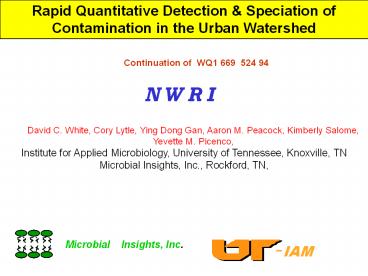Rapid%20Quantitative%20Detection%20 - PowerPoint PPT Presentation
Title:
Rapid%20Quantitative%20Detection%20
Description:
Rapid Quantitative Detection & Speciation of Contamination in ... Protozoa Cryptosporidium, Giardia , Microsporidium, Algae. Indicators pf pathogen infectivity ... – PowerPoint PPT presentation
Number of Views:46
Avg rating:3.0/5.0
Title: Rapid%20Quantitative%20Detection%20
1
Rapid Quantitative Detection Speciation of
Contamination in the Urban Watershed
Continuation of WQ1 669 524 94
N W R I
David C. White, Cory Lytle, Ying Dong Gan, Aaron
M. Peacock, Kimberly Salome, Yevette M. Picenco,
Institute for Applied Microbiology, University
of Tennessee, Knoxville, TN Microbial Insights,
Inc., Rockford, TN,
-IAM
Microbial Insights, Inc.
2
WQ1 669 524 94
Objectives 1). Rapid (lt 1 hr) Quantitative
sensitive method for CONTAMINATION Detection to
monitor multiple sites in the watershed
2). Allows for regionalized intensive
treatment in an integrated watershed system
CONTAMINATION Drugs, hormones other
pharmaceutically active compounds
-ppb Differentiate Pathogenic Bacteria
including especially VBNC pathogens Enterics,
Legionella, Mycobacteria, indicators for
virus Protozoa Cryptosporidium, Giardia ,
Microsporidium, Algae Indicators pf pathogen
infectivity
3
Sampling Urban Watershed --- Scheme 1
- Strategically placed coupons at multiple sites
for biofilm formation - Biofilms are readily invaded by Pathogens and
Nurtured - Lipids in biofilms serve as a built in solid
phase extractor for hydrophobic drugs, hormones,
bioactive agents - 5. Convenient to recover analyze for
biomarkers - Its not in the water but the slime on the coupon
4
Sampling Urban Watershed --- Scheme 2
- Coupon sequentially extracted high
pressure/temperature - Supercritical Carbon Dioxide ? Neutral
Lipids - (residue) Chloroform/methanol ? Polar lipids
- Analysis by HPLC/ES/MS/MS
- (residue) Mild Acid , SFE ? Lipopolysaccharide
OH FA Analysis by GC/MS - Analysis on GIS Basis by automatons neural
network ANN - Feedback to purification interdiction systems
5
In the Drinking Water Biofilm
Reproducibly Generate a Drinking Water Biofilm
1. Add from continuous culture
vessels Pseudomonas Spp. Acetovorax
spp. Bacillus spp. 2. Seed with trace
surrogate/pathogen E. coli (GFP), Mycobacterium
pflei (GFP), Legionella bosmanii ,
Sphingomonas
6
Biofilm Test System
7
(No Transcript)
8
(No Transcript)
9
Detecting specific pollution Drugs, hormones
bioactive compounds
Recover from biofilms Triculture biofilm E.
coli (GFP) established 3 days in presence of 1000
ppb drug ? Extract ? EI/MS/MS Beads
Beads Biofilm Waste Caffeine
4.7 50 ppb 3.7 37 ppb
97 Triclosan 3.7 37 ppb 15
160 ppb 84 Monensin 0
0.18 1.8 ppb
99 Finasterdine 0 0.4
4.2 ppb 98 Caffeine LOD
2 ppb disinfectant widely used in toiletries
LOD 25 ppb macrolide antibiotic used as
antiparastic in cattle chickens factories
LOD2 ppb (Proscar) inhibitor
of testosterone hydroxylase LOD 300 ppt
Biofilms concentrate bioactives compared to
sterile surface
10
ESI (cone voltage)
Q-1
CAD
Q-3
ESI/MS/MS
11
Finasterdine Q1 scan
373.3
373.3
Product ion scan
305.4
12
Coupon Biofilm
Extract with SFECO2
?
1. Neutral Lipids
UQ isoprenologues UQ-8 Enterics, UQ-9
Pseudomonas, UQ-10 Protozoa
Derivatize N-methyl pyridyl Diglycerides (cell
lysis) Sterols, Cholesterol (Protozoa),
Ergostrerol (Fungi)
Extract Residue with Chloroform.methanol
2. Polar Lipids
Lipid Biomarkers
?
Phospholipids, PC, PE, PG, sn1 sn2 FA Amino
Acid PG, 0rnithine lipids, Plasmalogens
Acidify, Extract residue with SFECO2
?
3. LPS OH FA
Transesterify, GC/MS . ? 30H 100, 120
Pseudomonas
30H 140 -- pathogens enterics
13
Respiratory Ubiquinone (UQ)
LOD 3 ppb (3.7 fmol/uL) 104 Bacteria ,
UQ-8 E. coli Enterics, UQ-9 Pseudomonas,
UQ-10 Protozoa, Algae, UQ-12,13 Legionella
Q7
Q10
Q6
197 m/z
14
Parent product ion MS/MS of synthetic PG
Q-1 1ppm PG scan m/z 110-990
(M H) -
Sn1 160, Sn2 182
Q-3 product ion scan of m/z 747 scanned m/z
110-990 Note 50X gt sensitivity
SIM additional 5x gt sensitivity 250X
15
Gram-negative Bacteria ? lipid-extracted
residue, ? hydrolize 1 Acetic acid , ? extract
Lipid A
- Acid sensitive bond
to KDO
?
?
14
14
E. Coli Lipid A ? 3 OH 140
16
Lipid A from E. coli Fatty acids liberated by
acid hydrolysis followed by acidcatalyzed
(trans) esterification
3OH 140 TMS
GC/MS of Methyl esters
3OH 140
140
phthalate siloxane































